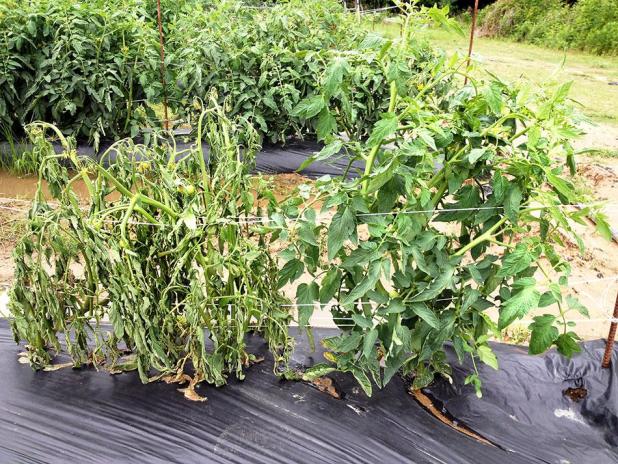
Tomato plant infected with Southern bacterial wilt (left) next to a healthy plant.
—LSU AgCenter/Raj Singh
Diseases on the rise in Louisiana vegetables
BATON ROUGE — Vegetable growers all over Louisiana are facing Southern bacterial wilt and bacterial spot in tomatoes and pepper production.
LSU AgCenter plant doctor Raj Singh said Southern bacterial wilt is caused by the soil-borne bacterium, Ralstonia solanacearum.
“The pathogen is spread within fields by the movement of infested soil, in surface water and through the handling of infected plants,” he said.
In addition to vegetables of the nightshade family, the bacterium can cause disease in a wide range of ornamentals. Infected plants rapidly wilt due to loss of turgidity of leaves and stems, giving the plants a limp appearance.
“Initially, these plants may recover overnight,” Singh said. “But as the disease develops, rapid drying of the foliage occurs, leading to permanent wilting and death of the plant.”
Brown, sunken cankers are often visible at the base of the plant near the soil line. Symptomatic plants will exhibit discoloration of the vascular system and the pith.
“Managing southern bacterial wilt in soils previously infected with the bacterium presents a real challenge,” Singh said. “There are no effective chemicals registered for commercial or home growers.”
Disease prevention is the key in reducing the spread to uninfected sites. Soil fumigation may reduce the incidence of disease early in the season, but it has not provided long-term control.
Soil solarization of contaminated fields during summer may also help in reducing the initial population of bacterium in the soil.
“Cultural management of Southern bacterial wilt includes avoiding planting susceptible crops in infested fields, planting on raised beds, avoiding late plantings of tomatoes in areas known to be infested. Also, the use of long-term rotations with non-host crops, such as corn, beans and cabbage.
Commercial as well as home growers must follow good sanitation practices to reduce the spread of the disease including avoiding movement of infested soils, avoiding movement of stakes from known infested sites to other sites and proper cleaning of tools.
There are no commercially available resistant/tolerant varieties that we can recommend, Singh said.
“Bacterial leaf spot of bell and hot peppers caused by Xanthomonas species, is a damaging disease and can lead to severe yield losses,” he said. “The pathogen is known to infect all above-ground plant parts including fruits, leaves and stems.”
Symptoms start with small tan/brown spots, which become large dark brown in four to five days. Leaf spots are irregular in shape with water-soaked margins and appear greasy. Infected plants defoliate prematurely and rapidly.
The pathogen is seed-borne, and disease development is favored by warm and rainy weather. Water splashed from rain or overhead irrigation aids in disease spread to nearby plants.
“Management of bacterial leaf spot requires an integrated disease management approach,” he said. “Growers must purchase certified disease-free seeds from a reliable source.”
Scout transplants for any symptom development and avoid planting them in the field. Plant in sunny locations with good air circulation to reduce the length of time the leaves remain wet.
Avoid the use of overhead irrigation and water in the early morning hours to reduce the extended period of wetness.
Fixed copper sprays applied prior to the onset of rainy periods will provide some protection.
